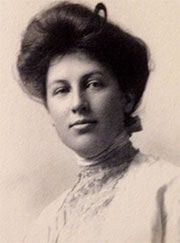 Engineer of the Week No. 87: Nora Stanton Blatch (Mrs Barney) PhD, PE, FSEI, MCOPRI, FASCE (30 September 1883 - 18 January 1971) On her 136th birthday we remember civil engineer Nora Stanton Blatch, who was the USA’s first female engineering graduate. Although Nora Stanton Blatch was born in England, her family moved the USA when she left school. She was accepted into Cornell’s Sibley School of Engineering as part of the first wave of female students, and became the USA’s first female engineering graduate in 1905, when she graduated from Cornell University with a cum laude degree in civil engineering. This acheivement is slightly less surprising when you realise that both her mother and grandmother were leading campaigners for the women’s vote. Her final year thesis was on “An Experimental Study of the Flow of Sand and Water in Pipes under Pressure”. One of her professors, Ernest William Schoder, wrote in a letter of recommendation for Barney that “She can use her hands and head, separately and together, better than many male seniors.” Nora’s first job was for the New York City Board of Water Supply. In 1908, she married the wireless valve inventor, Lee de Forest. They spent their honeymoon in Europe promoting his products including a live broadcast by her mother, from the Eiffel Tower, on women’s rights. Back in New Jersey, she was refused a job in his capacitor factory, despite having an engineering degree which her husband did not have. In 1909 she not only had her daughter but she also began working as an assistant engineer and chief drafter for the Radley Steel Construction Company, and left her husband. The main reason why the marriage failed within a year was that De Forest could not bear her working and, in 1911, told the New York Times that they were divorcing because Nora was “all mentality and ambition, and persisted in following her career as a hydraulic engineer and an agitator.” In 1912, she was employed by the New York Public Service Commision as an assistant engineer. From 1914 she worked for the Public Works Administration in Connecticut and Rhode Island as an architect, engineering inspector and a structural-steel designer, eventually becoming a real estate developer, with her architect daughter. Nora died in 1971. In 2015, nearly a century after she was refused membership of the American Society of Civil Engineers (ASCE) she was posthumously elected to ASCE Fellow status. In 2017, the New York City Department of Environmental Protection (DEP) honored her work on their water supply facilities by naming their 30-million-dollar tunnel-boring machine “NORA”, in use during repairs to the New York City’s Delaware Aqueduct. The project is considered the largest repair in the history of New York City’s water supply. Speaking about the project, Barney’s granddaughter Coline Jenkins said “Nora will be pushing forward and breaking ground, as she did in life.”
0 Comments
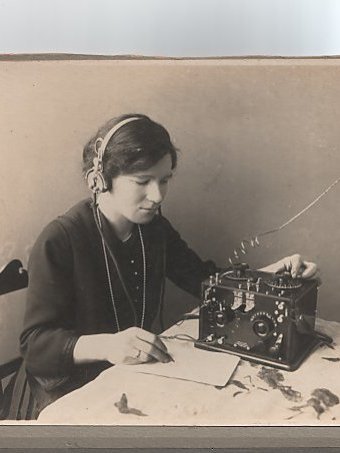 Engineer of the Week No.86: Florence Violet McKenzie OBE, ASTC, MWES, FAIN, MRNARS (nee Granville or Wallace) (28 September 1890-23 May 1982) On her 119th birthday we remember Mrs Violet McKenzie, Australia’s first female electrical engineer, founder of a telegraphy school and initiator of the WRANS. Violet McKenzie was usually known as Mrs Mac to the thousands of men and women who passed through her telegraphy training school before during and after WW2. Australia’s first female electrical engineer, Mrs Mac’s Wireless Shop in Sydney and Wireless Weekly magazine were also firsts for that country. Born in Sydney in 1890 Florence Violet Granville mostly used her stepather’s surname, Wallace, until she married in 1924. Always tinkering with electrical things as a child, after she had attended Sydney Girls’ High School, Florence applied to study electrical engineering at Sydney Technical College but they would not admit her unless she ws working in the trade. So she printed some business cards, found herself some electrical work and returned to the college with the proof and then graduated in 1923. By which time her shop and magazine were well established amongst electricians and amateur radio enthusiasts. She was Australia’s first female ‘ham’ radio operator. The most detailed account of her life and work is at https://dictionaryofsydney.org/entry/mckenzie_violet which recounts how she established the Australian equivalent of the UK’s Electrical Association for Women in the 1930s. As the Second World War approached she started teaching morse code to members of the Australian Women’s Flying Club. Then, in 1939, she set up the Women's Emergency Signalling Corps (WESC), with the idea to train women in telegraphy so that they could replace men working in civilian communications. By the time war broke out, 120 women had been trained to instructor standard, which was just as well as it soon became obvious that both civilians and military needed morse training, and very quickly. Some 12,000 men and women of all the services were trained at Mrs Mac’s school. When she offered to bring her female instructors into the Royal Australian Navy, the old guard there were horrified, despite the success of the WRNS in the UK. They rapidly backed down when she threatened to take her instructors to the air force and her initiative led to the establishment of the Women’s Royal Australian Navy (WRANS). Postwar she continued to offer her morse code classes until 1954 which, as if they were not already remarkable enough, she never charged any money for, meeting all the costs from her husband’s modest salary. Many merchant navy officers and airline pilots came to her for training and in 1978 a group of them laid on a celebratory party for her on Mother’s day. She died in 1982. 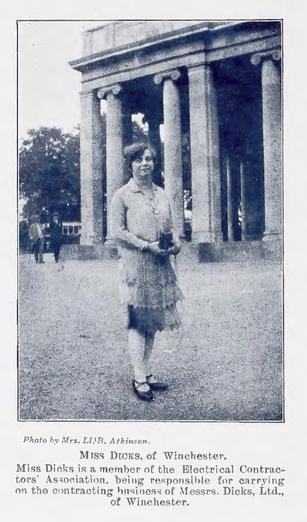 Engineer of the Week number 85 Jeanie Dicks (25 September 1893 – 6 July 1980) was responsible for the first permanent electrification of Winchester Cathedral in 1934. Maude Jeanie Dicks was born in Winchester, Hampshire to Philip and Frances Maude (née Henning) Dicks and baptised at St Maurice’s Church on Wednesday 17 January 1894, alongside her older brother Philip John Dicks (d. 1921). Dicks and Sons had been set up as a gas fitters by her grandfather, John Dicks and taken over by his sons Philip and John in 1888. The company expanded and took on heating, lighting electrical and refrigeration work over the years. After the death of her father Philip in 1926, Jeanie Dicks, age 33 and the only surviving child in the third generation, took over the family firm, now called Messrs. Dicks Ltd of Winchester. We know little about her life up until this point, but assume she has been involved in the family business. By 1928 Miss Dicks was the first woman member of the Electrical Contractors Association and attended their annual conference at Cheltenham Spa [pictured] (where her photograph was taken outside the Pittville Pump Rooms by Mrs Nelly Atkinson*). In a mass photograph of the ECA members in 1931, Jeanie Dicks is the only woman pictured. She was also a member of the Women’s Engineering Society and the Lyceum Club. In 1931, Jeanie Dicks won her company the contract to electrify the Deanery in Winchester for the newly appointed Dean, E Gordon Selwyn and Mrs Phyllis Eleanor Selwyn (nee Hoskyns). It must be remembered that electricity was still seen as a new and potentially dangerous technology at the time, with many houses and public buildings still lit by gas. A “Wizard in the Wall” marketing campaign was run in the 1930s attempting to demystify electricity. Recently donated papers in Hampshire Records Office show Miss Dicks as a very efficient project manager introducing electricity into an old dilapidated house suffering from damp, the enemy of electricity. Her company offered a bespoke service, drawing plans for the electrical circuits, designing, ordering or making suitable fittings. She seems to have built a good working relationship with the Selwyns, which stood her in good stead as the Dean was about to start a long term restoration and modernisation of Winchester Cathedral. In September 1933, Messrs Wingfield-Bowles, the London based consulting engineers for Winchester Cathedral, issued a call for tenders for the electric lights and accessory works. Miss Dicks enquired about submitting a quote… And so in 1934 Jeanie Dicks began to manage the first permanent electrification of Winchester Cathedral. Her firm also installed new heating and later a sound system. A "Woman's Cathedral Job” was widely reported in the press, with the Lancashire Evening Post writing “She is Miss Jeanie Dicks, Winchester, and in a month’s time she and her engineers will have completed the first part of their task. Miss Dicks…secured the contract in competition with famous British and Continental firms." There was even an article in the Sydney Mail in Australia with a cartoon captioned “a woman in in charge of the installation of light and heat in Winchester Cathedral – and the men obey!” The International Women News reported far more thoughtfully on her “great care in avoiding risk of fire and in securing that an essentially modern development is in harmony with the ancient beauty it is to illuminate.” It was a complicated job, and she supervised each element herself. It was discovered that to replace the choir-stall gaslights with electricity that cables would need to be run through the crypt. Electrifying the nave was the largest part of the operation but Dicks reduced the task by laying the cables at the same time as new central heating pipes were put in. This had necessitated removing and reburying coffins – except for that of Jane Austen, whom they managed to move gently to one side. Five miles of wire, capable of withstanding the cathedral’s infamously damp conditions, was especially created for the job by Messrs W T Henley’s, a firm which had specialised in creating insulated wire and waterproofed cables since the mid nineteenth century. To ensure that the lighting was correct, Dicks and two of her staff, foreman Charlie Wicks and Ralph Slade, spent many evenings in the cathedral with the two men up in the roof experimenting with different types of lighting for Dicks to judge for effectiveness down in the nave. The extensive trials resulted in her recommendation for lights hidden by frosted glass. She had a reputation for knowing what “looks right”. The electrification contract alone was worth £3,000 (the equivalent of around half a million pounds in 2018), and the heating and lighting work seems to have grown from the original plans, stretching into the 1940s and costing more than £20,000 in the end. The company’s work wasn’t limited to the cathedral alone, Dicks Ltd is considered to have “illuminated Winchester” electrifying most of its churches, The Castle, and the Assizes Court as well as some of the great houses of Hampshire, including Beaulieu. The company expanded beyond Hampshire and in 1934 Miss Dicks secured a contract from West Riding County Council for the electrical work for a new sanatorium at Scotton Banks. As Managing Director of Messrs. Dicks Ltd, she employed a staff of 75–90 people and was responsible for securing the jobs to keep them employed in the fields of radio, water engineering and plumbing. She encountered a certain amount of sexism where clients insisted on speaking with her male staff but rose above it to ensure that her firm was hired by well-heeled clients. Ralph Slade later said that "she wasn’t an easy lady to work for but she was always a fair one and her employees stayed with her". Winifred Holtby, the novelist and journalist, referred to her in her seminal 1935 book Women and a Changing Civilisation as "without thinking too much about it they have as successfully broken the line between "women's interests" and "men's interests", as the English woman electrical engineer, Miss Jeanie Dicks, who secured the contract for rewiring Winchester Cathedral". In April 1937, Miss Dicks was married to Ian McVean, a traveller for Beeston Boiler Company, in Winchester Cathedral by the Dean, Gordon Selwyn, and all the staff were invited to the service. As a wedding gift the Dean gave the couple an inscribed a copy of his book The Story of Winchester Cathedral, especially bound in white vellum. By March 1939 The Woman Engineer reported that "New ground has been covered by Mrs I. McVean who has been elected President of the Winchester Chamber of Commerce". The 1939 England and Wales Register (Census) taken on 29 September, records that she and Ian lived in Flat 3, Lansdown House, Winchester. As well as “Managing Director Heating engineers, Electrical engineers, Plumbers" she is listed as an ARP Ambulance Driver. During the war years, work continued at the cathedral but lots of Ministry of Works contracts are also undertaken. By 1954, she was president of the Electrical Industry Benevolent Association, Hants and Dorset branch. Soon after she exchanged notes with the soon to retire Dean Selwyn who reminisced about how pleased he still was that they had won the argument for the installation of radiators in the nave of the cathedral. [photo] In 1960, she decided to retire. She sold the business in two parts, with four staff members buying the electrical contracting side from her for one pound and naming the new firm Dicks (Electrical Installations) Ltd. The firm continued to operate in Winchester and working on large national and international electrification projects until 2018. Mrs Jeanie McVean died on 6 July 1980. The Hampshire Chronicle describing her a “one of the City’s leading business women over a period of 40 years’. Guest Author Ceryl Evans @politicdormouse [email protected] 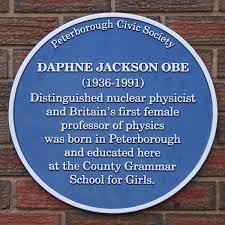 Engineer of the Week No.84: Professor Daphne Frances Jackson OBE, PhD, ARCS, FinstP. DSc, FIEE, CEng, CPhys, FRSA (23 September 1936 – 8 February 1991) On what would have been her 83rd birthday we remember nuclear engineer and founder of the UK’s returner fellowships programme, Daphne Jackson. Born and schooled in Peterborough, Daphne Jackson came from a very modest background. Her father was a machine tool operator and her mother had been a seamstress. Nevertheless, her attendance at Peterborough County Grammar School for Girls gave her what may have been an exceptionally good grounding in science for a girls’ school at that time and she was able to go to Imperial College and graduated in physics in 1958. She then went to the Battersea Institute of Technology (then part of the University of London and now part of the University of Surrey) to do her PhD on “The nuclear density distribution and optical model parameters of Li6”, lithium 6 being one of the stable isotopes of natural lithium. By that point she had already been appointed as an assistant lecture at the college and had started her prolific research publications, with several published papers before she had even gained her PhD. She authored or co-authored some 120 papers and books during the ensuing 30 years, including text books and basic introductions to nuclear science as well as her own specialised research. Initially her work was on the structural models of nuclei. In the 1970s she had become interested in the absorption behaviours of the pion subatomic particle but the final decade of her life was focussed on the medical use of nuclear physics and she was involved in the development of diagnostic tools we now take for granted, such as tomography used in medical scanners. This incredible level of publication was reflected in her rapid academic rise from assistant lecturer to professor in 1971, much heralded as the first female professor of physics in the UK, becoming Dean of Faculty 10 years later. Along the way she also became the Institute of Physics’ (IoP) youngest ever fellow (1966), and gained a DSc from Imperial College in 1970. She became and fellow of the IEE and vice president of the IoP in 1974, and was awarded the OBE in 1987. Jackson joined the Women’s Engineering Society in 1966 and was actively involved in the society until her death. In 1971 she aatended the 3rd International Conference of Women in Engineering and Science and took special interest in how engineers were educated at both further and higher education levels. She became the Society’s president in 1984, which must have been a hectic time for her as, in 1985, she founded the fellows’ scholarship scheme to assist women to return to careers in engineering, that would be named in her honour after her death (Daphne jackson Fellowships), securing hundreds of thousands of pounds from industry to fund the scholarships. In 1991 she lost her fight with cancer - a disease she had been helping to fight through her research with the Institute for Cancer Research and the Royal Marsden Hospital, and on which she had published so many papers. 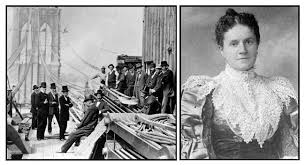 Engineer of the Week No.83: Emily Roebling (nee Warren) (23rd September 1843 - 28th February 1903) Today we remember one of the USA’s most renowned women engineers, Emily Roebling, for her role in building the Brooklyn Bridge. Emily Warren Roebling, who completed the construction of the Brooklyn Bridge, was another of those indomitable women who was an “engineer-by-marriage”. Although the youngest in a large New York family she was lucky enough to get a good school education before meeting her husband during the American Civil War. She married engineer Washington Roebling in 1865, just before his father John Roebling started work on the Brooklyn Bridge design, and they were sent off to Europe for Washington to learn about caissons (cofferdams) which its construction would need. When they returned to the USA in 1867 Emily already had a new baby but they were thrown straight into work on the bridge as Washington’s father had died following an accident at the construction site. In 1870, Washington was struck down with decompression sickness following an accident in the caissons protecting the foundations of the new bridge. Although he survived, he was further incapacitated by a series of strokes and was confined to bed and barely able to communicate. Fortunately for the project, Emily’s involvement from the beginning meant that, despite having no formal engineering training, she was very well versed in the details of bridge construction, such as the strength of materials, stress analysis, cable construction, and even the necessary calculations. She took over the day-to-day running of the project, communicating the day’s instructions to the supervisors on site, based on her discussions with her husband. She also had to deal with the politicians and even other engineering companies which, by 1882, were pressing to get her husband’s contract as chief engineer, on the grounds of his incapacity. Her constant presence, evident knowledge and authoritative speeches to those in power meant that many assumed she was in fact the bridge’s designer. Although she herself never claimed to be an engineer, let alone ‘The Bridge’s Engineer’, others certainly respected her as one, with E. F. Farrington, the chief wire engineer on site, referring to her publicly as “the first female field engineer”. At the opening of the bridge in 1883, she was the first person to cross the bridge, where her contribution to its completion is marked with a plaque. The remainder of her life, apart from the care of her husband and ailing son, remained in the public sphere. She took a law qualification at New York University, where she won a prize for her article entitled “A Wife’s Disabilities.”. Emily was very involved in a number of women’s organisations as well as writing and campaigning for women’s rights and can be seen as having been amongst those women who laid the ground for the coming campaign for women’s suffrage. She died in 1903. 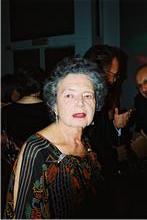 Engineer of the Week No.82: Maria (Marja) Ludwika Ziff (Mrs Watkins) BSc, C.Eng., MIEE, FIET, FRSA (circa 1918 – September 2010) In the month of her death, 9 years ago, we remember Maria Watkins, defence electronics engineer. Maria Ludwika Ziff was born in 1918 in Vienna, of Ukrainian parents who were working in Lvov, Maria left in 1938 to study electrical engineering at the University of Edinburgh, the professor having believed her application was from a Polish man. Her family refused to join her and only her younger sister survived the concentration camps. She graduated in Electrical Engineering (Communications) in 1941, and then became a technical assistant at Johnson and Phillips Ltd, who made cabling and navigation items for aircraft, working on technical problems of their distribution systems. Her job included supervising the repair of overhead power cables shot down by drunken solders to repairing electrical exchanges damaged by bombings. She was also a research assistant for new airplane guidance systems. During the war she lived in Blackheath, London where she spent her eventings as an air raid warden. She also did research for the PLUTO Pipeline Under The Ocean project and for a new secret airplane guidance system, in between her air raid warden duties. In 1947 she was appointed a lecturer at South East London Technical College and in 1959 a Lecturer, later a Senior Lecturer at Northampton College of Advanced Technology, now the City University, and also a visiting professor Worcester Polytechnic Institute, Boston, USA. She did research in medical electronics and published about 13 papers on these subjects. Maria was a member of Council and Senate of City University for three years and a member of Council and the Qualification board of the Institue of Electrical Engineering from 1976 to 1979. She became a freeman of the City of London and member and senior steward of the Worshipful Company of Scientific Instrument Makers, and a Fellow of the Royal Society of Arts and a fellow of the IEE. She joined the Women’s Engineering Society as soon as she arrived in the UK in 1939 and took an active part in the London Branch, the Society’s submission to the Finniston Enquiry, and its work with schoolgirls. She was WES President in 1980-81 and in 1984 donated the Watkins Medal to the society to be awarded to the best female engineering graduate of the year. She married Thomas (Tom) Brown Watkins, a fellow engineering student, when he returned from the war in 1946 and they lived in Sydenham and had two sons. Away from work her interests were English history, astronomy and skiing. She died in 2010. 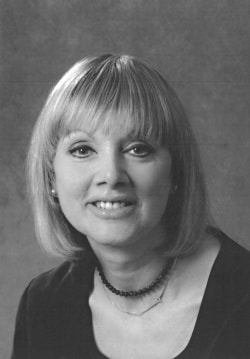 Engineer of the Week No.81: Jane Anne Plant (Lunn Simpson) CBE FREng FRGS FRSA FRSE FRSM CEng CGeol FIMMM FAEG FGS (1945-2016) This week we remember Professor Jane Plant, geochemist, metallurgist and expert on the effects of environmental chemicals and diet in cancers. Professor Jane Plant had a many-faceted career in earth-sciences, metallurgy and even health authorship. Similar to many of our amazing engineering foresisters, Jane’s initial education was not, on the face of it, in engineering: she started in geology but via geochemistry and metallurgy came to be considered not just one of the leading geochemists of her era but also an important engineer. Jane Ann Lunn was born in 1945 in Derbyshire, England. She was educated at Ashby de la Zouch Grammar School for Girls and gained a first class honours degree in geology from the University of Liverpool. She then joined the British Geological Survey and went to work for Stanley Bowie at the BGS Atomic Energy Section, where she developed geochemical survey methods to identify resources of economically important metals stream sediments in the north of Scotland. In 1977 this earned her a PhD on "Regional Geochemical mapping in Great Britain with particular reference to sources of error", from the University of Leicester. She rose quickly through the BGS and in 2002 became its first female Chief Scientist. Jane had also been awarded the CBE in 1997 and become the Institution of Mining and Metallurgy’s first woman president in 2001 Her work led to the worldwide applications of such databases, in mineral exploration, environmental issues and pollution, and in studying the health of ecosystems and humans. Her research areas also included metallogenesis and crustal evolution. She was proactive in public understanding of science and in encouraging young women in her field. Jane had several bouts of cancer which led her to research and publish on how diet and chemicals (such as cadmium and others) in the environment can affect susceptibility to cancer and other aspects of human health. Her first marriage was to Dr. Ian Plant, and she later married Peter Simpson, a BGS colleague. 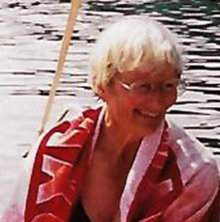 Engineer of the Week No.80: Elizabeth ‘Betty’ Audrey Killick FREng, FIEE, BSc, HonDSc (10th September 1924 – 7th July 2019) On what would have been her 95th birthday we remember the recently-deceased defence electronics engineer, Betty Killick, who was also the first woman to become a fellow of the Royal Academy of Engineering. Betty Killick was one of the UK’s top, top-secret engineers, who worked her whole career in defence electronics. Said to have been simultaneously terrifying and inspiring to her colleagues, she was also a surprisingly irreverent person when dealing with the heirarchy, which her American counterparts found hilarious. Unlike many women of her generation who entered engineering, there was nothing in that line within her family background. She was born and educated in south London and her father was an accountant who rose to become the Director of Finance to the Cotton Board. Drafted into the Women’s Auxiliary Air Force (WAAF) in about 1942 she became a radar mechanic, considered an elite trade by other WAAFs, because of the knowledge of maths and physics required to be accepted for training, but this gave her a taste for engineering. On demobilisation she worked briefly as a lab assistant at the Institute of Aviation Medicine, at Farnborough, before taking a degree in natural philosophy (physics) at St Andrews University. When she graduated in 1951 she joined the Antenna Division of the Admiralty Signals Establishment near Portsmouth. Her early work was included revolutionary developments in defence radar and sonar systems. Of course her work in this field was and remains very secret but in 1969 she was permitted to publish some papers on microwave antenna arrays, at the 1st European Microwave Conference. One of the few publicly available descriptions of her work is from Royal Academy of Engineering’ citation in 1982, when she became its first female Fellow: “She rapidly made a name for herself through her work on broadband low-sidelobe reflectors, and on high power frequency scanning antennas. She later led a group developing an electronically scanned antenna and associated phase shifters, capable of handling 1MW of peak pulsed power. This was successfully demonstrated in 1969 as part of a radar which was electronically scanned in elevation and mechanically scanned in azimuth with a limited “look-back” facility by frequency scan.” In 1969 she moved to the Admiralty Underwater Weapons Establishment (AUWE) at Portland in Dorset, where she led development of new homing, propulsion and guidance systems for torpedoes. These systems were key to the long success of the Spearfish weapons used in submarines, and the smaller Sting Ray light torpedo fired from helicopters and aircraft, such that versions of these are still in use in the Royal Navy. Her rise through the Civil Service’s scientific ranks was swift. She was promoted to Senior Principal Scientific Officer in 1966 and was further promoted to Deputy Chief Scientific Officer and Head of the Underwater Weapons Department at the AUWE ten years later. As well as her FREng, she was also honoured with a fellowship of the IEE (1980) and an honorary doctorate from St Andrews University (1988). Although quick to ensure equality for herself in her unique role at such a high level in the Scientific Civil Service, she absolutely rejected any labelling that mentioned her gender, prefering to be regarded as an excellent engineer with no reference to her gender. On her official retirement from the Civil Service in 1984, she had a brief, unsatisfactory stint with GEC, but then joined the Marine Technology Directorate, facilitating knowledge transfer between academia and industry. She spent her retirement in a Sussex village and died in 2019. 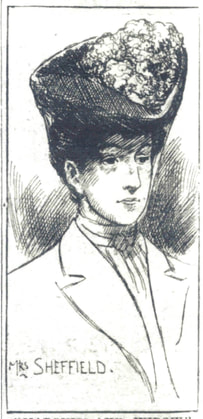 Engineer of the Week No.79: Eliza Dinah Fairchild (AKA Mrs Evelyn Diana Turnour Sheffield) (6th September 1856- 28th November 1942) 163 years after her birthday we remember the highly colourful life of Evelyn Sheffield, a real “Eliza Doolittle” as in Shaw’s play Pygmalion, or how even a barmaid may take up engineering! Mrs Sheffield cannot be compared to any of the female professional engineers who began their careers during her lifetime but hers is such an extraordinary story that the rules on ‘who is an engineer’ just have to be bent a wee bit to include her so that we can tell her tale. Eliza Dinah Fairchild was born in 1856 into a working class family in Southampton and had no engineering training or education that we are aware of but she and her brothers attended the Peninsular and Oriental Steam Navigation Company’s school in Southampton, until at least the age of 14. Their father was a ship’s steward, a trade which Eliza followed in her early life as she became a barmaid. In 1877 she married Henry Digby Sheffield a minor member of the aristocracy. At this point many ‘facts’ become immersed in a sea of fantasy, lies and downright fraud. She and Henry invented a ‘posher’ background for her, claiming that she had been born in Cadiz, Spain, the daughter of a British naval officer and a Spanish aristocrat. She took the name Evelyn Diana Turnour Fairchild, ‘Turnour’ being the surname of this imaginary naval father, and went by the name of Mrs Evelyn Sheffield from then on. Henry and Evelyn lived the leisured life of his class, travelling to the USA and Canada where they enjoyed big game hunting and fishing. In 1888, whilst Evelyn was in the UK, her husband died in Florida. The newly-widowed Evelyn was soon living openly with a John Lewis Garden, a Suffolk landowner and big-game hunter, with whom she seems to have enjoyed a relationship from before 1884 or before. When he died in 1892 she gained £7,000 from his estate (following a court case), enabling her to pursue her own interests for the rest of her life. She never married again. Now we come to the engineering. Tony Martin’s family blog (https://www.lostcousins.com/newsletters2/aug19news.htm ) gives the full details of this period of her life. She had developed aninterest in medical treatments and had the idea that the use of hot dry air could be therapeutic for a range of ailments. In 1893 she learnt that an engineer, Mr Thomas Henry Rees, had taken out a patent for a hot vapour treatment device and they got a patent for their “ An Improved Medical Dry Bath for Applying Superheated Steam or Gases and Medicines in Vapour to the Human Body”. However a Mr Lewis Tallerman also got involved at this point and Rees’s contribution to the technology became invisible. The therapy became known as the Tallerman-Sheffield hot-air treatment, even being written up in the medical journal, The Lancet. However in 1900 various legal disputes arose between the partners in the company. Both Rees and Tallerman were experienced businessmen and probably Sheffield had not been able to adequately protect her interests when the partnership was set up. Tallerman Institutes were set up at which the ‘baking’ treatment was offered to sufferers of rheumatism and joint problems, often being free for the poor. In another bizarre turn of her life, in 1901 Evelyn was initiated into the esoteric Hermetic Order of the Golden Dawn at its Isis-Urania temple in London. Soon after that she was again embroiled in another court case, which became a very high profile scandal in such national papers as the News of the World. In 1905 she most ill-advisedly brought, and lost, a breach of promise case against the Marquess Townshend. They each thought the other was wealthy but both were soon disabused. Her fake identity was exposed and the offer of marriage was withdrawn on the grounds ‘that the plaintiff was an adventuress and a clairvoyant and otherwise unfit to become Marchioness’.” Her lifestory with her invented persona was very widely publicised and seems very likely to have had at least some influence on George Bernard Shaw’s play, Pygmalion, which was published in 1913, in which of course the working class girl raised from the gutter is even called Eliza. Tallerman did everything he could to expunge Mrs Sheffield from association financially or otherwise with his therapeutic work. She must have considered herself to still have interests in the field because, in the 1911 census she gave her occupation as ‘medical’ and in the 1939 national ID Card register as ‘inventor of medical dry air baths and pads’. She lived in various quite nice London houses until her death in 1942 when she left only about £300 to an engineer called Percy Lock. She never relinquished her invented identity even in official documents. So, was she an ‘engineer’? An independent and enterprising woman, certainly, and her involvement in engineering was essentially no less than that of Sarah Guppy (suspension bridge patentee), but most of her life was coloured by her legal problems which probably made it hard for her to follow her interests in innovating. 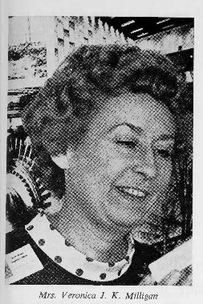 Engineer of the Week No.78: Mrs Veronica Jean Kathleen Milligan (“Ronnie”, nee O’Neil) BA, C.Eng., MIEE, AMBIM (11th March 1926 - 3rd September 1989) Today we remember electrical engineer Ronnie Milligan on the 30th anniversary of her death. Born in 1926 in Pontypridd, South Wales, “Ronnie” Milligan (nee O’Neil) would spend her entire life living and working in the Principality. Her father was a school teacher and it initially looked as though Veronica would follow in his footsteps, as she gained a degree in English and Economics from the University College of South Wales and trained to become a teacher. However marriage to Francis Milligan in 1945 led to her joining him and her brother, Maitland, in studying part-time for an HNC in electrical engineering, whilst also raising her two baby sons. By dint of offering to work for nothing with the South Wales Electricity Board she was instead offered a paid graduate traineeship and hence became the first female engineer in SWEB. Her first big responsibility was to check and rectify all air break links in the 11kv line in a district, with a gang of 12 far more experienced men to oversee, after previous engineer electrocuted himself. 1959 she gained her chartered engineer status with the Institution of Electrical Engineers (now IET), and moved to planning electrification schemes. In 1961 she and her husband set up their own consultancy, CivLec Industrial Advisory Services, which was intended to be part time while they both had jobs but quickly became too demanding so the consultancy became full time. She took a diploma in management studies and became a member of the British Institute of Management. This led, in the 1970s to many appointments with government advisory panels on industrial management, principally in the heavy industries and nationalised industries, including the Commission on Energy and Manpower and the Council of Engineering Institutions. Having joined the Women’s Engineering Society in 1964 she was soon active, setting up and running a new branch in Wales in 1966, joining the WES council in 1968 and becoming the society’s president in 1978-79. Her great interest was in careers guidance for girls and she visited scores of schools in Wales promoting engineering careers, as well as advising careers guidance professionals. She died in her long-time home in Rhiwderin ,Newport, Gwent in 1989 after a short illness and was survived by one of her two sons. 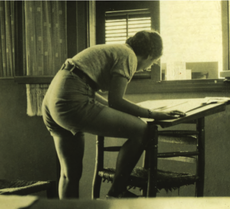 Engineer of the Week No.77: Marjem or Marynia Chatterton (nee Znamirowska/Znamerovschi) BSc, FIStructE. (September 1916 – March 2010) 103 years since the month of her birth in Poland we remember structural engineer Marjem Chatterton, who was a real pioneer in the then newly-emerging nations of Israel and Zimbabwe, as well as an early female engineer in her field. Marjem Chatterton was the first female fellow of the Institution of Structural Engineers and designer of many of Zimbabwe’s first skyscrapers, including that nation’s national bank building. Born Marjem or Marynia Znamirowska in Warsaw, Poland, in September 1916, she grew up in a large Orthodox Jewish family, where girls’ education was considered important. She had planned to return to Poland to study chemical engineering at the University of Warsaw, but in 1934 it was clear that the situation for Poland’s Jews was worsening, so she enrolled at the Hebrew Technical Institute in Haifa. Known as the ‘Technion’, one of her aunts – Rachel Shalon, the first female engineer in the country – was a faculty assistant there. Photos of Marjem in class show that she was far from being the only woman studying engineering at the Technion. Graduating in civil engineering in 1939, with the first distinction in engineering awarded by the Technion, Znamirowska took a job that had been offered to her by a faculty member, Josef Edelman, who ran the Technical Office of the Collective Settlements Association, building some of the country’s largest kibbutzim as well as factories and bridges. She also assisted with paramilitary roles during the war. Although her own parents escaped from the Nazis, most of the rest of the family were lost in the Holocaust. In 1947 the war, Marjem and her British husband, Frank Chatterton, emigrated with their children to Southern Rhodesia, where she found a job as a reinforced concrete designer within 2 days of arriving in the country. Her experience with reinforced concrete structures in Palestine was particularly useful, as at that time it was nearly impossible to get hold of heavy steel sections locally. Southern Rhodesia was socially very conservative and everyone was taken aback to be working with a femal engineer but, once her competence became evident, her ‘oddity’ meant she was soon very well-known. Specialising in multi-storey structures, Initially she worked for Lysaght and Company but in 1969 she established her own consulting firm, M. Chatterton and Partners. As well as prestigious urban skyscrapers, she also designed many industrial facilities for the cotton, fertiliser, and sugar industries. In 1976, the worsening political situation in Zimbabwe led to her moving to Leeds University as a lecturer, and also became involved in the university’s campaign to encourage girls into engineering, giving careers talks in girls’ schools. In 1984 she returned to consultancy in Zimbabwe, also teaching at the national university. Zimbabwe’s independence in 1980 meant that sanctions were lifted and investment poured in and she gained a lot of work and her buildings still define the skyline of Zimbabwe’s capital Harare, with her last major project – the 26-storey Reserve Bank – being the tallest office building in the country. By 1999, although Marjem was still working (at the age of 83), the political situation was again worsening and she decided to take retirement and return to the UK. |
- Home
- Electric Dreams
- All Electric House, Bristol
- Top 100 Women
- Engineer of the Week
- The Women
- Timeline
- WES History
- EAW
- Teatowels For Sale
- 50 Women in Engineering
- Museum Trails
- Waterloo Bridge
- History Links
- Blue Plaques
- Virtual Blue Plaques
- Career and Inspiration Links
- Contact
- Outreach
- Photo Gallery
- Bluestockings and Ladders
